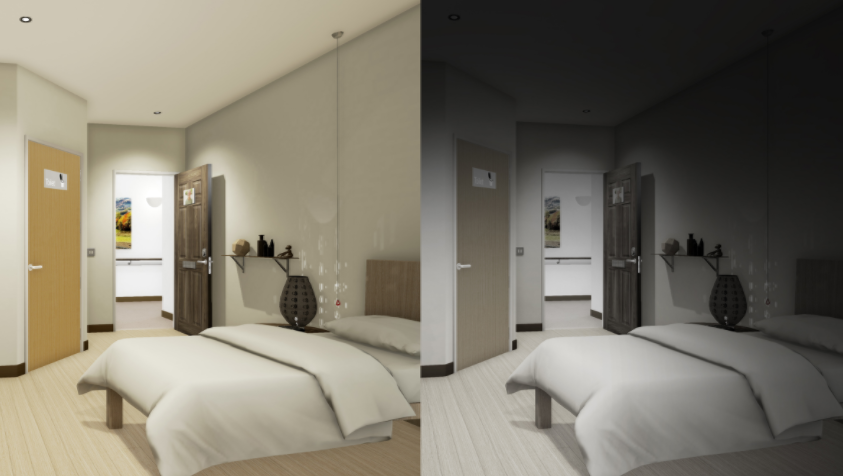Virtual Reality Tool Helps Architects Create Dementia-Friendly Spaces
A virtual reality device has been launched that will help architects and designers create dementia-friendly buildings and spaces by mimicking the visual impairments experienced by dementia patients.
The invention is a market first for architectural design and will be known as Virtual Reality Empathy Platform (VR-EP). It stems from the knowledge that people with dementia can see things very differently, with objects often appearing dimmer and less colourful than they really are which can lead to fright and confusion.
The technology can be used in the design of new buildings such as care homes, hospitals or sheltered housing, and also has the potential to assess existing buildings and environments. Dementia-friendly design can significantly improve the quality of life for people living with the condition.
The virtual reality kit includes a high-performance laptop, a virtual reality headset, a games controller, a camera, and specially designed software.
There are currently more than 800,000 people in the UK alone living with dementia, a figure that is expected to rise to 1.7 million by 2051. This application can help healthcare providers save expensive adaptive costs by designing buildings and spaces with the person living with dementia in mind.
By using this device to see things through the eyes of a fictional person living with dementia, building or interior designers will be able to create homely and familiar environments that could reduce accidents, lessen anxiety and help those living with dementia live more independent lives.

The appearance of a room without and with the Virtual Reality Empathy Platform headset, for a dementia sufferer.
The idea is the brainchild of David Burgher, director at Scottish Borders-based Aitken Turnbull Architects, who has developed the product in partnership with Glasgow CGI company Wireframe Immersive and experts at the Dementia Centre, HammondCare. The Dementia Centre is recognised as a world leader in dementia support, care and design. It provided the evidence-based research and academic rigour to this product. Wireframe Immersive has developed the virtual environment and will supply the software and hardware.
David Burgher said: “At Aitken Turnbull we have many years of experience in designing buildings for the elderly and for people living with dementia and have gained valuable insight into the condition, allowing us to empathise with those who live with it.
The introduction of this unique VR-EP technology takes this insight to the another level - giving building designers first-hand experience of how dementia affects vision so that we can design spaces that are far better suited to people living with the condition.
“As well as reducing anxiety, the improved design offers a better, safer and more independent quality of life. Dementia-friendly design doesn’t have to cost more. In fact, by using VR-EP, designers will get it right first time and therefore reduce costs.”
VR-EP comprises a laptop with high performance graphic and memory capability, Virtual Reality goggles, a games controller, camera and bespoke software programming.
Kevin Gordon, Business Development Manager at Wireframe Immersive said: “VR-EP is leading edge technology being developed by Scottish companies and a fantastic example of how virtual reality can be used to improve quality of life. The scale of dementia and its associated costs is colossal, not just in the UK but across the globe. VR-EP also has the potential to be adapted to simulate other sensory impairments and be used across a spectrum of disorders, so its potential is enormous.”
Professor Mary Marshall, Senior Consultant at the HammondCare Dementia Centre’s UK team said: “One of the biggest challenges for researchers, trainers and consultants in dementia design, is how you convey the experience of the environment for people living with dementia. This device has the potential to be immensely beneficial for researchers, commissioners, architects and interior designers, and many other professionals in this field, and the Dementia Centre, HammondCare are delighted to be part of it.”
The VR-EP device was developed with £50,000 of funding from Scottish Enterprise and is projected to generate ten times that amount of sales (£500,000) by year three of trading. Aitken Turnbull Architects and Wireframe Immersive are currently carrying out a scoping exercise with interest from Scottish Development International (SDI) to export this virtual reality device to Europe, China and the States.
David McHoul, Innovation Specialist at Scottish Enterprise said: ‘This project is another great example of Scotland’s strengths in innovation and our support will help develop this ground-breaking dementia design and empathy platform to service a patient group which is globally underserviced. Initial research shows there is a strong demand for this product on an international scale and the VR-EP device will make a profound impact in improving the environment for those living with dementia.”
Aitken Turnbull Architects originated in the Scottish Borders in 1887 and is now the largest professional architectural practice in the South of Scotland. The practice services clients across the UK and further afield, from offices in Galashiels, Edinburgh and Dumfries.
Aitken Turnbull have a proven track record in health, specialist health, specialist education and research projects and have worked with ten of the fourteen health boards in Scotland. In addition, the practice is retained as sole architects for Macmillan Cancer throughout Scotland and Northern Ireland.
The practice designed New Struan, an independent residential and day school that is recognised as the most advanced centre in the world for the education of children with autism spectrum disorder.















